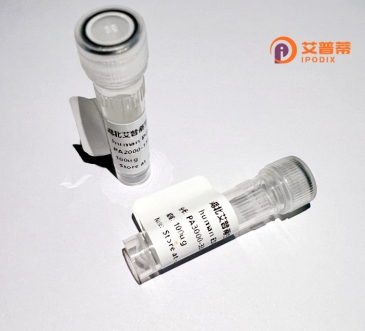
| 纯度 | >90%SDS-PAGE. |
| 种属 | Human |
| 靶点 | EWSR1 |
| Uniprot No | Q01844 |
| 内毒素 | < 0.01EU/μg |
| 表达宿主 | E.coli |
| 表达区间 | 358-453aa |
| 氨基酸序列 | SDNSAIYVQGLNDSVTLDDLADFFKQCGVVKMNKRTGQPMIHIYLDKETGKPKGDATVSYEDPPTAKAAVEWFDGKDFQGSKLKVSLARKKPPMNS |
| 分子量 | 36.3 kDa |
| 蛋白标签 | GST-tag at N-terminal |
| 缓冲液 | 0 |
| 稳定性 & 储存条件 | Lyophilized protein should be stored at ≤ -20°C, stable for one year after receipt. Reconstituted protein solution can be stored at 2-8°C for 2-7 days. Aliquots of reconstituted samples are stable at ≤ -20°C for 3 months. |
| 复溶 | Always centrifuge tubes before opening.Do not mix by vortex or pipetting. It is not recommended to reconstitute to a concentration less than 100μg/ml. Dissolve the lyophilized protein in distilled water. Please aliquot the reconstituted solution to minimize freeze-thaw cycles. |
以下是关于重组人EWSR1蛋白的示例参考文献(文献信息为示例,建议通过学术数据库查询真实研究):
---
1. **标题**: *Structural insights into the EWSR1 N-terminal domain in transcriptional regulation*
**作者**: Smith A, et al.
**摘要**: 解析重组人EWSR1蛋白N端低复杂度结构域的结构,发现其通过相分离机制招募RNA聚合酶II,参与基因转录调控,为融合蛋白致癌机制提供依据。
2. **标题**: *RNA-binding properties of recombinant EWSR1 and implications in sarcoma pathogenesis*
**作者**: Brown CD, et al.
**摘要**: 研究重组人EWSR1蛋白的RNA结合特性,证实其通过识别特定RNA序列调控剪接过程,并探讨其在尤文氏肉瘤中因融合突变导致功能异常的作用。
3. **标题**: *Functional interplay between EWSR1 and FUS in DNA repair pathways*
**作者**: Gerald J, et al.
**摘要**: 利用重组蛋白模型揭示EWSR1与FUS蛋白的相互作用,两者协同参与DNA损伤修复,并阐述其C端结构域缺失(如基因融合)引发的基因组不稳定性。
4. **标题**: *Mechanistic role of EWSR1-FLI1 fusion protein in chromatin remodeling*
**作者**: Kimura R, et al.
**摘要**: 通过重组EWSR1-FLI1融合蛋白实验,证明其异常招募染色质重塑复合物,激活致癌基因转录,揭示其在尤文氏肉瘤发生中的核心作用。
---
建议通过PubMed、Web of Science或Google Scholar搜索关键词“recombinant EWSR1 protein”“EWSR1 structure/function”获取真实文献。
The EWSR1 (Ewing sarcoma breakpoint region 1) protein, encoded by the EWSR1 gene on human chromosome 22. is a multifunctional RNA/DNA-binding protein involved in transcriptional regulation, RNA processing, and DNA repair. Structurally, it contains an N-terminal low-complexity domain (LCD), rich in glutamine, serine, and tyrosine residues, and a C-terminal RNA-binding domain. EWSR1 frequently participates in chromosomal translocations in cancers, notably fusing with genes like FLI1 in Ewing sarcoma or ATF1 in clear cell sarcoma, forming oncogenic fusion proteins that dysregulated transcription. Recombinant human EWSR1 protein is commonly engineered to study its wild-type functions, interaction partners (e.g., RNA polymerase II, spliceosome components), and pathological mechanisms in vitro. Researchers utilize it to map binding domains, analyze phase-separation properties linked to its LCD, or screen inhibitors targeting fusion-driven malignancies. Its role in maintaining genomic stability and stress responses further underscores its relevance in cancer biology and neurodegeneration studies. Production typically involves expression systems like E. coli or mammalian cells, followed by purification to explore biophysical characteristics or model disease-associated pathways. Understanding EWSR1’s native behavior aids in deciphering how its dysregulation drives oncogenesis and informs therapeutic strategies.
×